What does a kangaroo and an apple have in common? Apparently, a type of plant with fruit shaped like a kangaroo footprint. The kangaroo apple has a rich native history and is quite a superfood.
In our how to grow and care guide, we’ll introduce the kangaroo apple, go through some caring instructions, pests and diseases, and the plant fruit as bush tucker. We’ll also share some frequently asked questions about this Australian native.
More...
Family: | Solanaceae |
|---|---|
Genus: | Solanum |
Species: | Solanum aviculare Solanum laciniatum |
Common Names: | Kangaroo Apple, New Zealand Nightshade |
Location: | Outdoor |
Type: | Bush |
Growth: | Up to 3 metres tall and 3 metres wide |
Sun requirements: | Full sun |
Foliage Colour: | Dark green |
Flower Colour: | Purple |
Flowering: | Spring and summer |
Fruit: | Green and turning red/orange when ripe |
Maintenance level: | Low |
Poisonous for pets: | Yes |
Introducing Kangaroo Apple
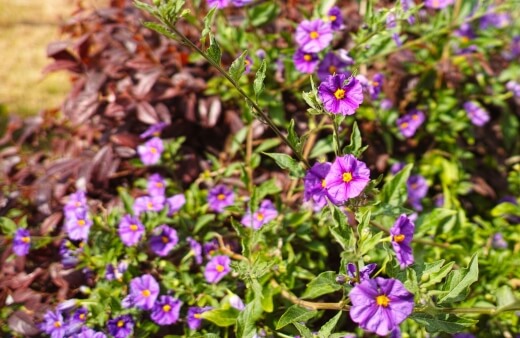
Kangaroo apple, like the family it comes from, is a remarkable native plant. It’s part of the Solanum family – it might sound familiar because this group of plants provides much in terms of food and medicine.
When we speak of kangaroo apple we’re actually speaking about 2 plants that are incredibly similar and of course related. These are Solanum laciniatum and Solanum aviculare.
Solanum laciniatum vs Solanum aviculare
If you’re looking to tell them apart, the first kind has lobes on its flowers and bigger seeds but also the flowers are a darker purple. Bloom time for the kangaroo apple is spring and summer.
Size wise, both Solanum laciniatum and Solanum aviculare are bushy in their appearance and grow around 3 metres high.
Now that we’ve cleared up the very small difference between the 2 types of kangaroo apple, we can talk more about what it looks like. The leaves are dark green and big and the purple flowers show off the resemblance to the Solanum family.
Kangaroo Apple's Fruit
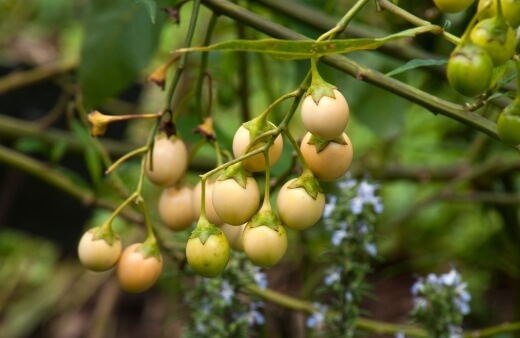
The fruit has been called the most interesting looking part of the plant – they are shaped like eggs and they change in colour as they become ripe. Imagine a display that changes from green to a reddish orange.
The kangaroo apple also produces plenty of fruit. So the most obvious question is probably, is the kangaroo apple related to apples? They are in fact unrelated.
Solanum aviculare is sometimes called the New Zealand nightshade. Generally when we hear nightshade we think pretty but poisonous.
The Solanacea family is known for having many poisonous family members. They are toxic because they have alkaloids in them but we do in fact eat some of these – think potatoes and tomatoes for example.
Kangaroo Apple Toxicity
When it comes to the fruit of the kangaroo apple, the fruit is only toxic when it’s not ripe. If you’re convinced that the kangaroo apple is a choice for your garden, just remember this is a subtropical plant. That means no frost.
Let’s set the scene for the natural habitat of this plant. The kangaroo apple is usually growing on the edges of forest, on shrub land, and places where sea birds like to nest.
Growing Kangaroo Apple in Australia

Source: tropical.theferns.info


Get Your Free Guide:
Master Growing Australian Natives eBook
A Must Have Complete Guide for Every Australian Garden
Get Your Free Guide:
Master Growing Australian Natives eBook
A Must Have Complete Guide for Every Australian Garden
Kangaroo Apple Propagation
You can propagate your own kangaroo apple using seed or a hardwood cutting. You’ll want to plant the seeds during the springtime and ensure the temperature is between 18 and 20°C.
At this temperature, the seeds should germinate in around 3 weeks. Once the seedlings are big enough, you can plant them in individual pots, at least 12cm or larger as they have very strong root systems. You can plant them in the garden the following summer.
If you’re using a cutting, it should be semi ripe and taken around the end of summer. The cuttings can take root in just a few weeks.
Caring for Kangaroo Apple
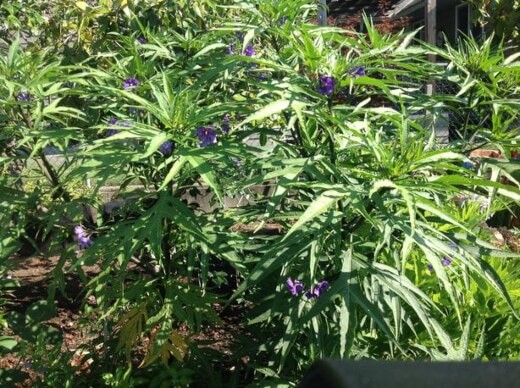
Source: usedvictoria.com
Using the Right Fertiliser
You have a few options when it comes to fertiliser. You can use a quick release fertiliser, a temperature controlled slow release fertiliser or even an organic fertiliser.
If you are using the water soluble quick release kind, every 2 weeks is perfect. If you use a slow release option, you would only apply once per growing season.
An organic fertiliser like fish emulsion will depend on the product and you can follow the application guidelines on the packaging. Click here and see our in depth guide on choosing the right fertiliser for your plants.
Sunlight Needs
Your kangaroo apple plant will need full sun in order to thrive. That means at least 6 hours of direct sun each day.
Best Soil for Kangaroo Apple
The kangaroo apple needs moist and well-draining soil. Adding compost to your soil is a great booster to help hold and drain water accordingly and mulch is the golden ingredient to maintain soil moisture.
You can use chalky, clay, loamy or sandy soil – this bush can handle most types of soil. In terms of pH, the soil can be acid, alkaline or neutral.
Watering Schedule
When planning your watering schedule for the kangaroo apple, a guideline is that the soil needs to be evenly moist at all times. You’ll need to let the temperature and climate conditions guide you but regular watering is recommended especially for the first 2 years of the plant’s life.
For the first year, rather water once per week but do a substantial deep watering to really nourish your plant.
Kangaroo Apple as Bush Tucker
The kangaroo apple fruit starts off as a bright green colour before it’s ripe. Solanum laciniatum becomes a yellow to orange colour as it becomes ripe and Solanum aviculare becomes an orange to reddish colour.
You’ll know the fruit is ripe not just with the colour change, but because they start to burst open. On the inside, you’ll see what looks like a cherry tomato and up to 600 seeds!
It’s probably no surprise then that the kangaroo apple is a family of tomato and eggplant.
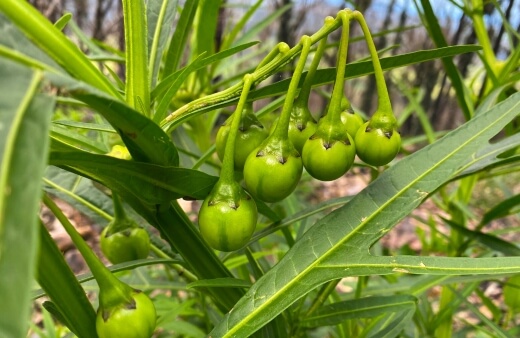
More on Kangaroo Apple's Fruit
Taste wise the fruit pulp is juice filled, delicious and sweet, a bit like melon. Just a heads up that an unripe kangaroo apple fruit is toxic. The native people of Australia and New Zealand have enjoyed the benefits of this plant for a long time, as a source of both food and medicine.
Nutrient wise, the kangaroo apple has plenty of vitamin C and beta-carotene. Kangaroo apple's fruit contains phenols, a type of antioxidant that guards against heart disease and cancer.
You’ll also find a type of steroid in the fruit which produces cortisone in the body. Talk about an important and health packed plant.
How to Eat and Prepare Kangaroo Apples
When it comes to enjoying the fruit of the kangaroo apple, you can eat it raw or cooked, depending on your preference and palate. Australians love to use it in baking and for making jam.
You can also roast the fruit and serve it with a meat dish. If you want to store kangaroo apple, the fruit can be dried for future use. Once the fruit is ripe, it goes off quickly so make sure you’ve got lots of recipes and inspiration at hand.
If you pick the fruit too soon, you can leave it somewhere sunny and warm until it ripens.
Read about everything from native herbs and vegetables, to medicinal bush tucker.
Pests and Diseases that Affect Kangaroo Apples
Whitefly
The name whitefly is deceiving as they are a type of bug and not actually a fly and there are about 1500 different species of whitefly. This pest creates a honeydew on the affected plant and this then causes sooty mould to develop as a result.
If you’re trying to figure out if you’re dealing with whitefly, here are some descriptions that might help. The adult ones look like small white flies and might fly off if the plant is moved or handled.
The nymphs are flat and green and they don’t move. The whitefly eggs are usually laid on the underneath of the leaf and can be white or yellow. You might notice that they form a circle.
Other signs that you’re dealing with whitefly are leaves that are turning yellow or your plant might look a little weak and sad.
You can get rid of whitefly eggs using soapy water or rubbing alcohol on a cloth. If you’re dealing with a light infestation you can use a spray of water to get rid of the pest and its eggs.
Another handy hint is using an ant trap close to your kangaroo apple. This helps prevent another infestation from happening. Insecticidal soap or a neem oil application are beneficial too and kinder to the environment. If you are going the organic route, you might need to apply your treatment more often.
Red spider mite
The red spider mite is a tough one because you can’t actually see it with the naked eye. They like warm temperatures and houseplants. A small and dusty looking web is a telltale sign and holding up a light to the plant can help you diagnose the problem.
The leaves might also have some yellow patches. The mites suck plant cells which creates the yellowing effect as the photosynthesis process is disrupted. The leaves might also dry up entirely.
You’ll need to try and get rid of the parts of the plant that are affected if you can. Red spider mites like dry conditions so a change in humidity can help. You could do something as simple as spraying the stems and leaves with water.
A natural plant oil is a good treatment as well to help keep numbers of mites down. Ladybugs find the mite delicious so if you find any, be glad they’re doing their part to help out. They’re supposed to be lucky too!
Aphids
This is a very common pest that is also small and sucks plant sap. They aren’t too harmful to a plant if you’re just dealing with a few. Once again, their sap-sucking affects the photosynthesis process and your plant will start to look a bit worse for wear.
The plant growth might look a bit strange and yellow leaves are common. This pest makes lots of honeydew which is loved by ants and also causes sooty mould.
The adult aphids can be a whole host of colours from green, to yellow to red. They are small and might have a waxy texture. The eggs are tiny white dots and found underneath the leaves.
Aphids like to hang out in parts of the plant with new growth so keep an eye out. If you’re dealing with a big infestation, you can use a strong spray of water to shake them loose.
A soap and water mix spray is also effective. It’s even been said that a spray with garlic or chilli in water is a great insect repellent. If you’re able to attract some natural predator insects to your garden, that is helpful.
Kangaroo Apple Frequently Asked Questions
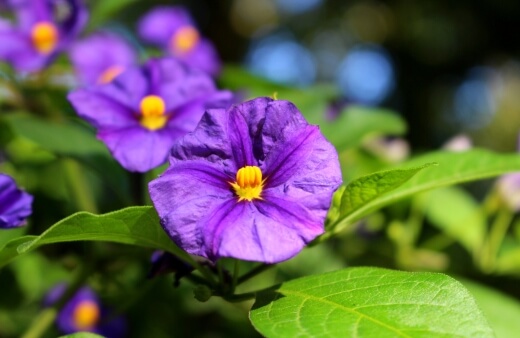
What was the kangaroo apple used for by the native Aboriginal people?
The kangaroo apple established itself as a great anti-inflammatory and antioxidant. Aside from being a source of medicine and food, the steroids and alkaloids in the fruit were considered very prized during the 60s and 70s.
Kangaroo apple was cultivated in Europe and China for use in a variety of products including medicine and beauty products.
Does kangaroo apple have any medicinal uses?
The unripe fruit and the leaves of the kangaroo apple contain the chemical Solsadine. This chemical is used to make cortisone based contraceptive products.
The fruit could also be crushed and applied to joints to help with inflammation and rashes.
When was the kangaroo apple first discovered and do you find it anywhere else in the world?
We know that the kangaroo apple is native to New Zealand and southeastern Australia where it grows wild. You would also find it in Tasmania and New Guinea.
Solanum laciniatum was discovered by Kew botanist and the gardener to the King of England, William Aiton in 1789. Solanum aviculare was discovered in 1786 by Georg Forster.
He was a German explorer and scientist and discovered the plant on a trip to southeastern Australia along with the famous Captain Cook on his journey around the world.
Need some more gardening tips and inspiration? Click here to sign up for our newsletter.
Wrapping Up Our Kangaroo Apple How to Grow and Care Guide
The delightful kangaroo apple is a gardener’s treat – it’s good looking with a floral display and the fruit it produces will fill many a pretty bowl and happy tummy (only when ripe of course).
We have many reasons to feel proudly Australian and our amazing native flora is just one of those. We’re giving the kangaroo apple our green thumbs up.
Published on September 12, 2022 by Nathan Schwartz
Last Updated on February 25, 2024





When planting kangaroo apple plants from seed, do you separate the seeds from the plant or plant the whole pod with seeds. The pods are dry and contain seeds. This is my first try. I live in Saskatchewan so must grow as an annual. Thank for any help.
Hi Gloria,
Plant the seeds individually. Allow the pod to dry out a little first too so it’s easier to separate the seeds. Also worth noting, if you’re going to grow it as an annual, you can store the seeds for twelve months so you don’t need to buy or harvest any more next year.
Just pop the dried seeds into a bag and store them somewhere free from humidity and light.
All the best,
Gary Clarke
Help! I’ve been introduced this year to Kangaroo Apple. I’m in Alberta Canada , zone 3, and we are headed for first frost within a week. Tonight it will be only 3 degrees Celsius.
My question is: my Kangaroo Apple seed pods have not had enough time to turn color. Can they ripen indoors and how would you recommend I do that?
As insurance I will take a cutting. Do I then place this cutting in water to grow roots or plant in soil?
Thanks,
Val
Hi Val,
In many ways it’s actually better to pick them before they’re ripe and let them ripen in a bowl indoors. They go off really quickly if you pick them when they’re fully ripe, so picking now might actually help you store them for longer anyway.
Once you’ve picked them, you can either leave them to ripen in their own time (keep them attached to a stem if possible) or just pop them in a bowl with a spotted banana or avocado. They produce more ethylene gas as they ripen, which triggers ripening in other fruit (works for pretty much everything!)
As for the cutting, the cold isn’t actually your main problem, it’s more the growth you’ll have available.
They work best from semi-ripe cuttings, which are most available in mid-late summer (anything that’s started to develop a thicker skin but not yet fruited). Try some in water, and some with rooting hormone in a moist pot of perlite and compost. Cut leaves back so there’s minimal foliage left on each cutting, and hopefully you’ll have some luck.
Also, just for a final sign of relief, the best way to propagate kangaroo apples is actually from seed, so when your fruits ripen, you could just save a few seeds for next year if the plant doesn’t make it through an Albertan winter.
Best regards,
Nathan Schwartz
Hi
I read with great interest your article on these plants.
I live on the central coast of California.
Poking around in my garden one day I saw a very strange plant. The stem was purple and the leaves very spikey palmates.
I researched on line, getting a lot of wrong identifications. Meanwhile the plant was growing so fast I was sure it was some noxious weed.It is now about 10 feet tall.
There is now another in the opposite corner of the yard which is about 12 feet tall.
Clearly they are very happy in our cool environment. How can they have come here?
Can I train them as trees?
Thanks for your site!
Hi Mary,
This is brilliant. I know it must have caused a bit of a stir for you, but I can’t hide my pleasure that our Aussie natives are finding their way across the globe!
Kangaroo apple is a brilliant Australian native, but it’s also pretty popular with plant collectors, and I think they’re sold for gardens in warmer parts of the US too. My guess is that a bird ate the fruit of a nearby tree, and it’s just been pooped out into your garden. I’d just take this one as a miracle of nature and make the most of it.
Kangaroo apples are definitely going to be happy in California, so I’m not surprised it’s self-seeding like that. They develop fruits that birds love, but it could just be that fruit from the first plant got kicked across the garden when it fell. Either way, it’s worth keeping them. They’re lovely plants, and well worth training – and yes, you can train them as small trees with a bit of extra work.
It naturally wants to be a mid-height shrub (so about 8-10 ft tall), but you can prune out the lower growth and coax it into having one leading trunk.
Definitely give the trunk some support with a vertical steel or timber stake though. I can’t find any simple examples of it with kangaroo apples, but there’s a good guide to doing the same thing with wisteria here: https://growingwithplants.com/2013/05/growing-awesome-wisteria/
Nathan Schwartz
Aussie Green Thumb